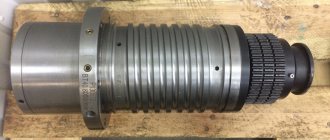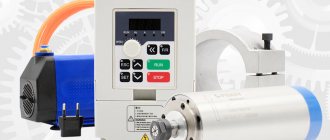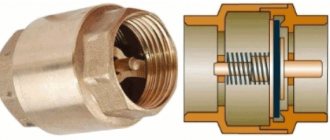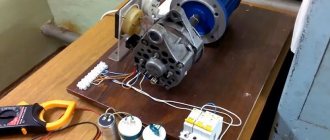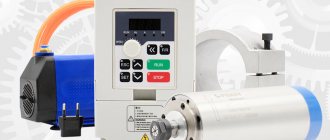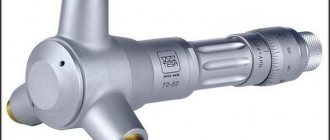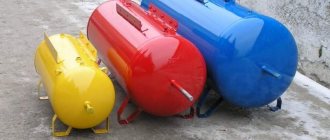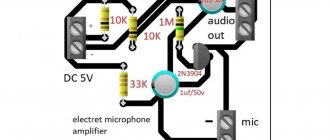18.03.2020
- Device and characteristics
- The principle of operation of the spindle and what it consists of
- Spindle use: what is it for?
- Classification of spindles by type, size and diameter
- Spindle type selection
- Selecting the type of cooling
- Selecting speed and power
- How to make your own spindle from a picture
- Service
Have you been involved in metalworking for a long time or are you just starting to study the theory? We will help you understand the basic skills. In the article we will talk about the machine spindle: what it is, show a photo of the tool holder and talk about how to work with it.
Device and characteristics
Metal processing on machines has become widespread. This is not surprising, with the advent of mechanized equipment, labor productivity has increased significantly, and the process of manufacturing metal products has become much simpler - workers spend less time on one production cycle.
The creation of machine tools also provided:
- Higher quality parts, good accuracy class.
- Reducing the final cost of all work.
- Increased production speed.
Almost no machine tool can operate without spindle locking – we’ll explain this using the example of a lathe. This is an element that is responsible for strong and reliable installation of the workpiece in one place. If we take a turner as an example, he attaches a metal bar or shaft between two headstocks, on one side of which such a holder is installed. The second very simple illustration is a drill. Here, in order to hold a drill or other tool, you also need to mount it inside the spindle.
The word itself is of German origin. Spindel is a spindle, that is, something that has the ability to rotate in different directions. Structurally, it is a shaft. The term itself is mainly used in such areas as machine tool building, metalworking and woodworking, respectively. This is an extremely important element; without it, the operation of not a single device can be imagined. The task of the part is to transmit the force generated by the electric motor to the workpiece made of metal, wood, or plastic. A device for centering and clamping this bar is attached to the shaft.
Let's explain again with a simple example to understand that there are two main purposes - to rotate and to hold the workpiece. A lathe has a spindle. A gear is attached to one side, through which force is transmitted. A bearing is located at the second edge of the shaft. A clamp chuck is attached to it.
But, it would seem, why else is it needed if you can attach a metal or wooden sample directly to the gearbox or gearbox? The fact is that these parts of the machine are not adapted to increased vibrations and high loads; they will simply break under them. But the shaft can become an intermediary, which takes on all mechanical (and thermal) influences. In addition, on one side there is a cartridge that has fastening elements - threads, splines, grooves, that is, they are universally suitable for the specific purpose of the fastener.
What are the features of the spindle device:
- Fastening is carried out using a rolling bearing. This is a durable unit, standard, but it also has different designs. For example, some may be vibration resistant, while others may be cheaper. Machines equipped with a cooling and lubricating fluid supply system work much better, because in this case the bearings experience less stress and friction, thereby significantly increasing their service life.
- The shaft receives its main rotational movement from an asynchronous motor. It is installed in the equipment housing - usually in the right headstock. At first, electric motors were powered only from three-phase sources and were installed directly in factories. They were believed to have higher power. But now they produce equipment that is powered by 220 V, so it can be placed under normal conditions - often turning or milling machines are located in garages and other “home” buildings for personal use.
- The spindle can receive rotational motion directly from the electric motor, but more often through an additional component, such as a belt. The belt drive is convenient - this part is inexpensive, easy to attach, and also easy to use, but at very high speeds it can slip. In such cases, when high speed is needed, gears and gears are installed.
- The main fastener, which is located at the edge of the shaft, is the collet chuck. This allows for reliable fastening of a shank of any diameter. Almost all tools for metal cutting and drilling are equipped with such a tip (tail), and if not, then they have to be attached along the outer edge, which is much less reliable and allows for significant discrepancies and vibrations.
- It is very important in industrial production to have a cooling system on lathes or milling machines. It is of great importance - it extends the maximum period of operation, as well as the time of continuous metalworking.
- The most complex spindles are found in CNC equipment. The fact is that the presence of a numerical control panel makes it possible to manufacture parts with maximum accuracy. This, in turn, requires minimal vibrations. Such high-quality equipment can be ordered online on the company’s website. Here you can find high-quality machines for processing metal workpieces.
- The degree of shaft fixation directly depends on the rotation speed. The higher it is, the more securely the fastening should occur.
Technical specifications
The device in question has an unlimited number of properties. The main technical specifications of a machine for milling work on metal include the following points:
- Power. In most cases, the power parameter is related to the parameters of the supplied electric motor. The criterion is measured in W and can vary over a fairly wide range. The choice of power takes place in accordance with the area of use of the machine.
- Rotational speed. The spindle of a milling machine can rotate at different speeds. At the same time, the newest models are distinguished by the fact that they can change the speed in steps or slowly.
The spindle milling machine is also classified according to the area of use. Depending on the power parameter, the following models are distinguished:
- For processing polymer materials and chipboard, as well as MDF, models with a power of 800 W are suitable. They cost a relatively small amount and are usually installed in a workshop at home.
- Wood, soft multi-colored alloys, textolite have a very high degree of workability. This is actually why the recommended power of the machine is 1500 W.
- Common steels, stone and hard alloys can be machined at 3000 Watts. This is quite enough for the cutter to cut into materials with very high hardness.
It must be remembered that too much power is not always considered an advantage of the equipment. This is due to the high energy consumption coefficient and price
When selecting, attention is often paid to the stepwise adjustment process.
Different designs of milling machines also determine the following characteristics:
- The efficiency criterion reaches up to 95%. Thanks to this, energy costs are significantly reduced and the efficiency of using machines is increased.
- High strength and reliability. If made well, the device will most likely last for a very long period.
- Design features make it possible to use the equipment for a long period without stopping. This is due to the presence of a cooling system.
In most cases, the operating characteristics of a spindle depend on the area of use and the required processing accuracy. In addition, a very high degree of machinability is ensured by cooling.
The principle of operation of the spindle and what it consists of
Almost all equipment with this element involves using a cutting edge on the prepared material. The design feature of the shaft is that it is possible to securely fix the tool in one of the machine operating modes - power or high-speed. In the second case, the main task of the device is to cut off the top layer from the surface of the workpiece as quickly as possible. The high-speed operating principle has its own special features:
- Productivity increases. Before simply choosing a high rotation speed, it is necessary to take measurements and enter all the parameters into the technological map.
- This option is most widespread in the case of finishing turning or fine milling, since only an extremely thin layer needs to be removed at high speed.
- The most common type of design is an asynchronous motor with a belt or gear drive.
- But sometimes there is simply no intermediary element. But because of this, you should not put too much force on the device, as this threatens to overload the motor. But this also significantly reduces the minimum dimensions of the entire installation, which is why direct connection technology is used in various hand-held power tools.
The second category - power devices - have the following characteristic features of manufacture and operation:
- Between the cutter (drill) and the fastening device of the electric spindle itself, it is necessary to insert bushings - these are conical spacers, which significantly increase the positive qualities of the product and reduce vibrations, and have a good effect on strength. They must be selected depending on the shank - diameter and type.
- It is not recommended to connect directly to the motor, as variable load will damage it. The main transmission method is V-belt or using gears.
Design Features
Layout of elements
Horizontal milling machines were one of the first types of equipment for performing metal processing operations. They are used for grinding, boring, milling, and in some models, drilling. At the same time, the layout of the models is often the same.
A frame is installed on the base, which serves as a support post. On its front part there is a work table with a gearbox and moving carriages. They are necessary to move the surface along the X and Y axes. An electric motor is installed at the rear of the structure, connected to the spindle head through a gearbox. Despite this general description, possible modifications or additions specific to a particular model should be taken into account.
Depending on the specific purpose, horizontal milling machines may have the following additional components and assemblies:
- cantilever design. With its help, you can change the position of the workpiece relative to the cutter. Some types of equipment have the ability to rotate the desktop at a certain angle;
- installation of a magnetic table. For processing parts of complex shapes, it is recommended to use electromagnetic tables, eliminating the need for mechanical fastening. In this way, the quality of milling processing can be improved;
- CNC machines. These are modern analogues of classic equipment. Using the CNC block, you can set the machine operating algorithm in automatic or semi-automatic mode. Relevant for instrument making or when processing large workpieces made of hard steel.
A separate category includes universal horizontal milling machines. Their purpose is to perform the entire range of processing operations. To do this, an additional spindle head on a flexible drive is installed in the design. This makes it possible to mill complex elements.
Spindle use: what is it for?
To begin with, we note that the scope of use is as wide as there is a lot of different equipment for metalworking and processing wood and plastic. If the main purpose of the part is to hold the equipment, then, accordingly, the application is based on the features of the toolkit:
- Every power tool that has an attachment cannot do without an electric spindle as a holder.
- A unit is needed for milling and lathes - they, in turn, are very widespread, since with their help you can create numerous products.
- Fixing rolled products for processing is another purpose.
But the most important function remains fixing the equipment. Moreover, the reliability of the fastening is so high that it allows you to achieve maximum rotations and maximum axial load on the shaft.
Manufacturing
As a basis, it is proposed to take a cheap milling machine with numerical control.
To design a spindle device you will need:
- electric motor (you can use the NTM brand, series 50-50, 5800 rpm and 2 kW);
- cone-shaped shaft;
- controller for electric motor;
- 2 bearings;
- collet clamp;
- a device for determining performance, including calculating speed characteristics during rotation, inclination angles, steps. This device is called a servo tester.
The latter can be purchased at a low price; it is only important when choosing to take into account the ease of fastening. https://www.youtube.com/embed/Khnh7IIz6Tw
Manufacturing technology:
- The design of the engine has two rolling bearings. Two bearings should also be installed on the shaft using holders. A collet clamp is installed on the extended shaft to secure the cutter. This device perfectly solves the issue of lateral loads that can arise not only during metal milling, but also during wood processing.
- Installing a controller on a homemade device helps stabilize torques in cases of load changes. This is necessary during finishing operations.
The stability of the homemade spindle can be adjusted using a servo tester.
Cooling system
It doesn’t matter whether the spindle is homemade or purchased, the design must include a cooling system. Varieties:
Varieties:
- Water. The housing has holes specially designed for the passage of water. Heating the metal releases heat, which is absorbed by the water. Warm liquid is poured into a container. The latter often interferes with the maintenance and repair of the machine, so another type of cooling is most common.
- Air. Air intakes help to blow air over the heated elements. But this device also has a drawback - the filters quickly become dirty and must be constantly cleaned. But spindles installed on a milling machine with this cooling system will last much longer.
Classification of spindles by type, size and diameter
There are various bases for classification. The first, and perhaps the main one, is what equipment the unit is intended for. Of course, different machines and electrical equipment require different instruments.
The second principle of differentiation is size. The devices come in different sizes, designed for industrial use and private use. In this regard, a variety of consumable parts are needed - larger and smaller. If you want to replace the spindle on your own machine, then when purchasing you must indicate the number of your equipment, name and year of manufacture (there may be different modifications).
Well, the last, but not intended, classification is by type. Shafts can be:
- Collector. This is a device that includes a high-speed collet roller. The main areas of use are milling machines, as well as engraving operations.
- Specialized for high speeds. They allow you to achieve significant metal processing speeds, therefore increasing productivity. But since good quality can only be achieved with great precision, high-speed models are used mainly only on CNC equipment. You can buy such machines on the website.
- Design with built-in cooling. The cooling system can be supplied through a part or liquid, or cold air. This increases the cutting speed and the degree of surface roughness, and friction becomes less, so wear also comes later.
There is another classification - by manufacturer. Of course, European production is more preferable than Chinese. In Europe, porcelain bearings are often used, which provide very positive performance.
Design features
Milling machines are installed in private workshops and industrial buildings. Nowadays, CNC options have become extremely popular, since the supplied control unit automates the processing process and significantly increases accuracy. The design of the spindle of a machine for milling work differs slightly from the corresponding unit of turning equipment, since in the first version the purpose is to secure a tool, in the other - a cylindrical workpiece. In addition, the chuck for the CNC spindle is made with greater accuracy, since a slight deviation will cause a loss of accuracy.
When analyzing what a spindle is and how it works, you need to pay attention to the following points:
- The base is provided by an iron shaft with very high axial load resistance.
- The specialized design that is designed to hold the cutter is provided by the combination of a mandrel and a collet.
- The possibility of a good fit of the mandrel can be eliminated by making the spindle in the shape of a cone.
- The modern design of a machine for milling work takes into account the location of the spindle on a specialized carriage, which can move in three coordinates at once. This ensures greater functionality and productivity. In this case, the drawing can be very complex.
- The circular motion is applied directly to the cutter. Many precision equipment does not have intermediate components, which significantly reduce the efficiency criterion and may cause rotational distortion.
- The most basic parameters are power and rotation speed.
The design features determine that the spindle structure of the machine for milling work makes it possible to install very different attachments. This moment significantly expands the scope of use of the device.
Spindle type selection
Now let’s introduce specific varieties, note their advantages and characteristic features. They should be taken into account when selecting parts.
With built-in electric motor (electric spindles)
They:
- Contributes to the development of very high speeds. With standard 18,000 - 24,000 rpm, some models can also support operating speeds of 120 thousand rpm.
- They cut very well at high speeds.
- They have limitations in loads - it is dictated by the use of small ball bearings.
- Not suitable for reverse. The absence of such a function makes it very difficult to create some elements, for example, cutting threads.
- Cones or collet clamps are most often used as clamps.
Mechanical with external drive
They:
- Deal with much lower speeds. The standard can be considered from 300 to 8,000 rpm. This is due to the fact that it is quite difficult to set in motion all the bearings, gears and other elements transmitting movement
- Rigidity and load capacity are greater. Why? because you can use not only ball bearings, but also more stable ones - roller bearings. So such equipment can even be used for power milling of titanium or other strong metals.
- There is feedback - provided that a motor with an encoder is installed.
- Tool cones are used instead of collets - the latter do not meet the requirements for fixation rigidity.
Selecting the type of cooling
Cooling of the rotation zone is required to increase service life. There are two types.
Water (liquid)
Differences:
- They are very quiet - the liquid flows almost silently. But at the same time there is another loud sound from the movement of the impeller.
- The presence of a circuit that includes a system of tubes, a container, and a pump. It is necessary to constantly monitor the moisture supply and its temperature.
- Can operate at low speeds.
Air
Distinctive features:
- Strong and not the most pleasant sound.
- Chips may fly away under the influence of a jet of air.
- It is necessary to clean the shirt where metal particles become clogged at regular intervals.
- It is required to monitor the temperature very carefully; ideally, install a sensor with a signal, because the entire device is very sensitive to overheating.
As a result, we recommend using the air option when working with soft materials, but when the workpiece is made of durable metal, it is better to use liquid cooling.
Service
Basic operating requirements:
- Timely cleaning of chips or chip removal system.
- Equipped with cutting zone cooling.
- Selecting and fixing the shank according to size.
- Do not insert a broken instrument.
- Eliminate excess vibration.
We talked about one of the most important parts of the machine. Be careful when choosing and using.
